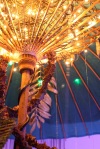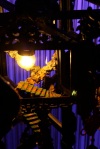Big Trouble In Little China, 2010
Sculptural Installation
The Binary Equivalent of the digits, 101010 is 42.
The number 42 is pan-culturally significant in aspects of religion; the Judaist word of God contains 42 letters. Ancient Egypt worshipped 42 Deities. In modern technology, the 42nd letter in the Ascii typeset is the asterix (*) and is progamatically defined as “anything and everything”.
In 1966 mathematician Paul Cooper theorized that if one were to travel between any two points on earth, the gravitational pull would paralyse the travel time to 42.2 minutes, regardless of its distance.
Appointing the relevancy and intention of speedily closing the time spent in commuting space we can address the translation of one culture through another. As Europe was fed her empire, the closed Orient kept aggressively quiet. The mystical continent of Cathay forbade foreign charter and the traded communicative device became its Ornament. As Europe politically and geographically enforced its empirical policy around the globe, aesthetic styles and decorative Ornament became a document to [the popular misconceptions of] a utopian and mysterious Cathay. European Craft applied its basis primarily from literature and the translations dictated by Spanish explorer Marco Polo. In the 17th Century, the word Chinoiserie fell on everybody’s lips.
The pictorial fantasies of Jean Baptiste-Pillement and Francois Boucher were examples of Chinois wonderment, always suggesting a perfect balance of fine and delicate architectural landscapes harmoniously married with lush, rich foliage. The utopian Cathay landscapes were weightless, floating islands of cross-sectioned earth, often in fusion with a European flourish of whipped gold. The toile vignettes represented a Shangri-La lifestyle and Cathay suggested one of agricultural virility/fertility and social and political freedom. As a consequence of overlapping misinformation, and much to the dismay of the Europeans, the geographical location of Cathay remained solely in the minds of the artisans and craftsmen who created it.
The work explores the anthropological [mis]conceptions between cultures ; how the fantasies and imaginations of the public consciousness are often passively shaped by the aesthetic sprawl of the Ornament, and how the wide-spread impact of pre-modern kitsch has provided utopian concepts that have echoed over generations.
LUKEWARM 2010.












